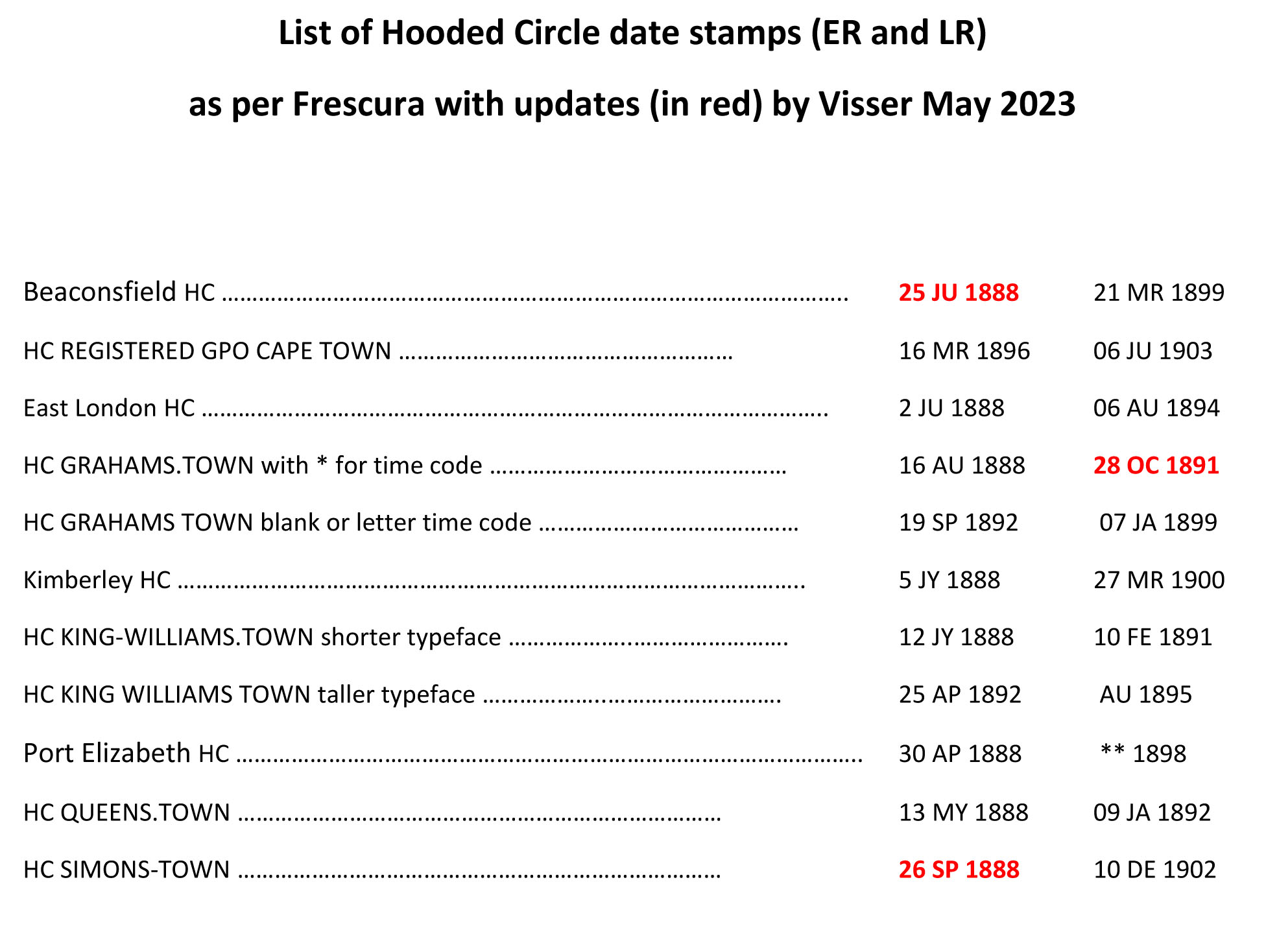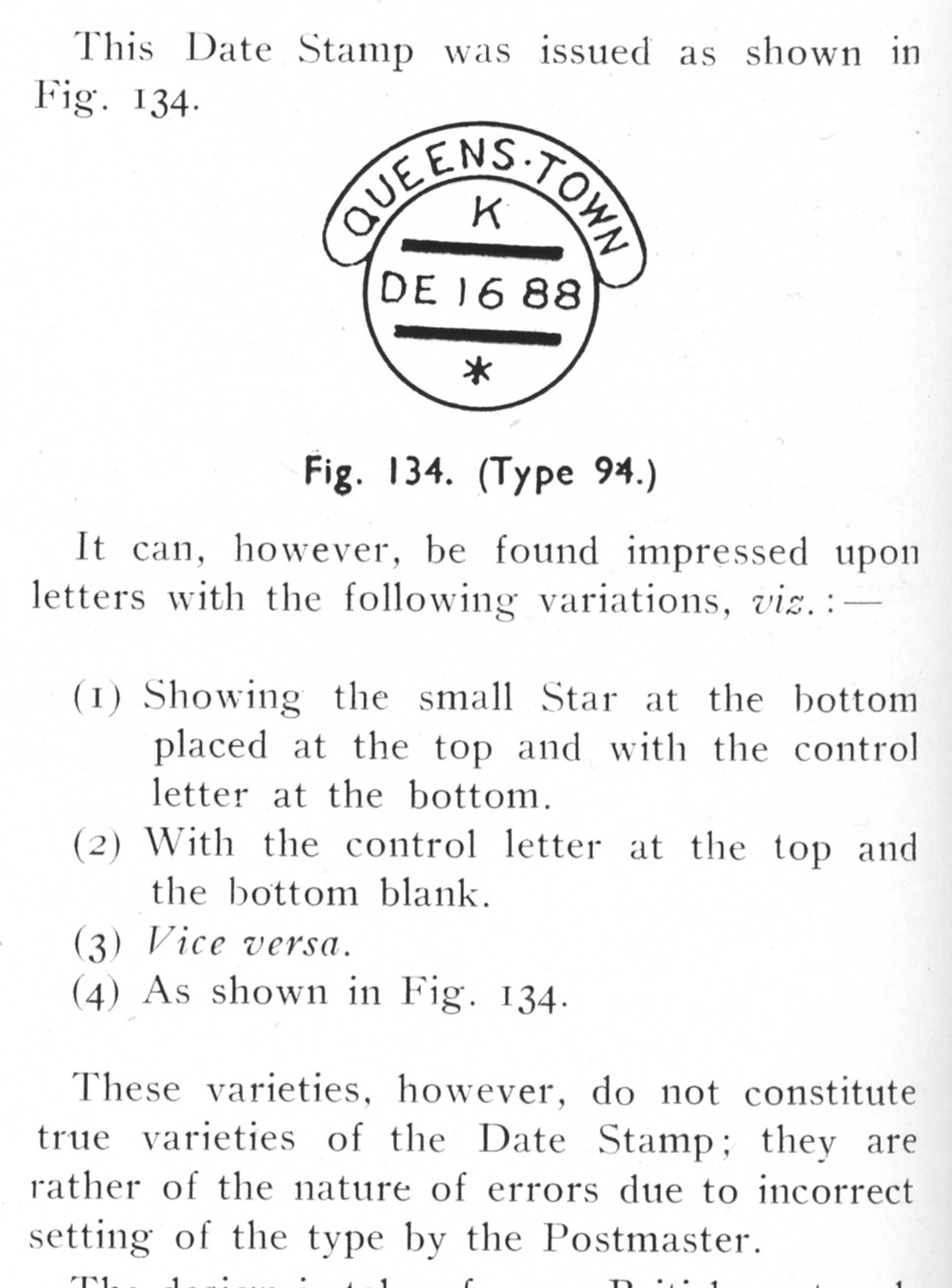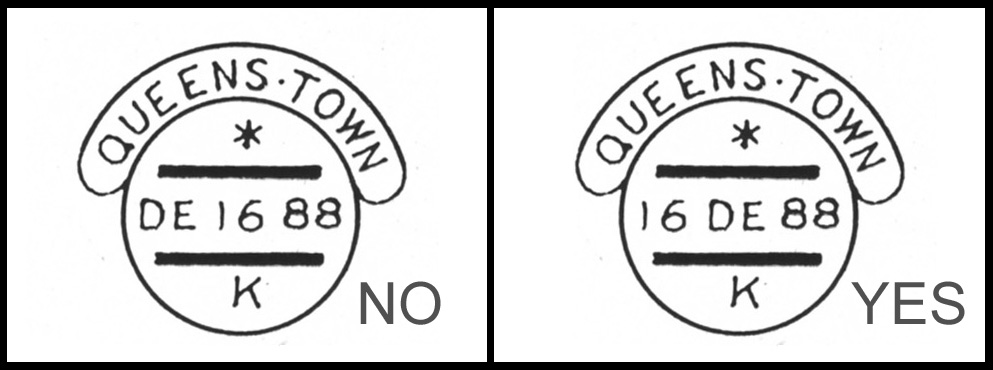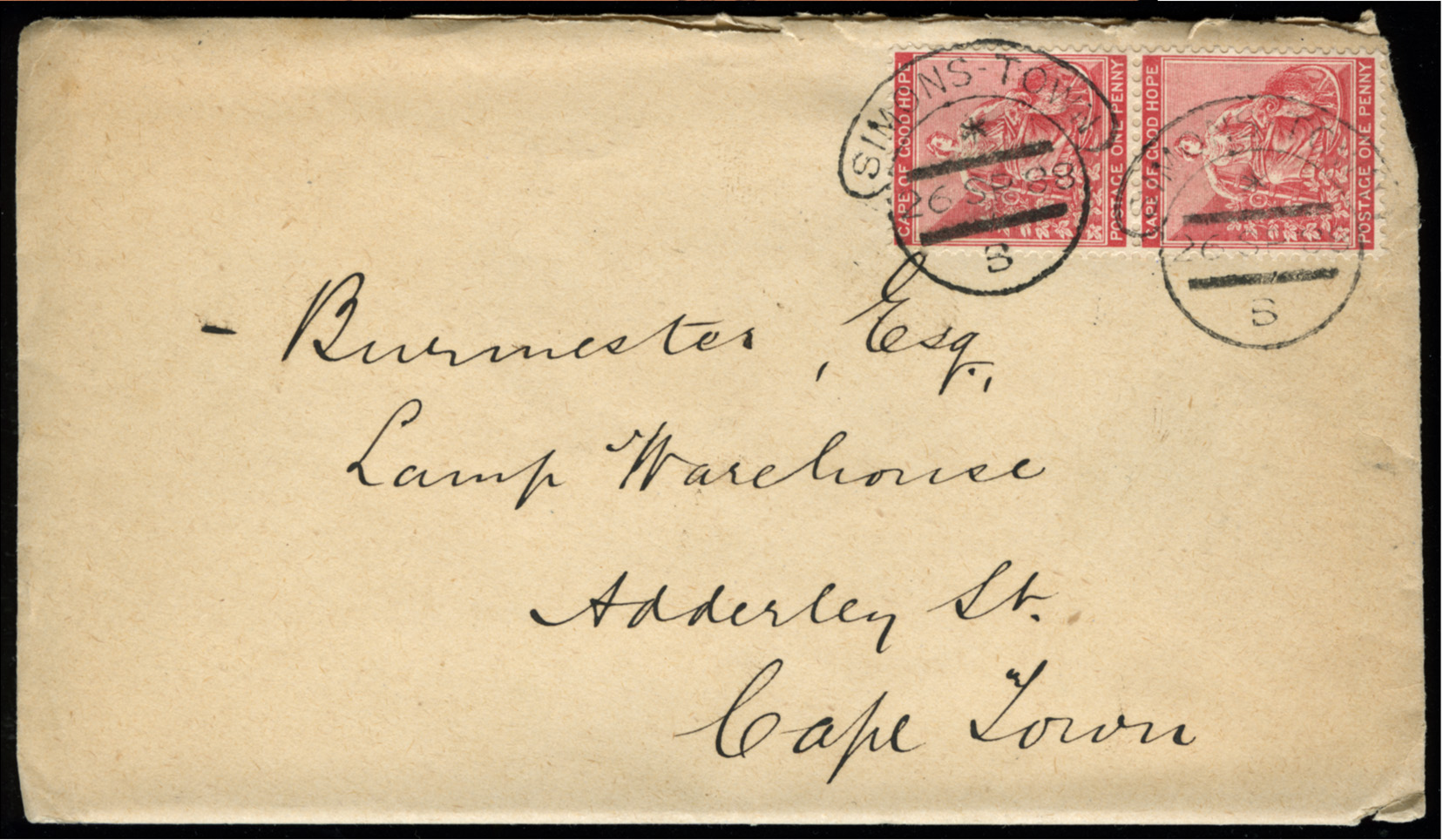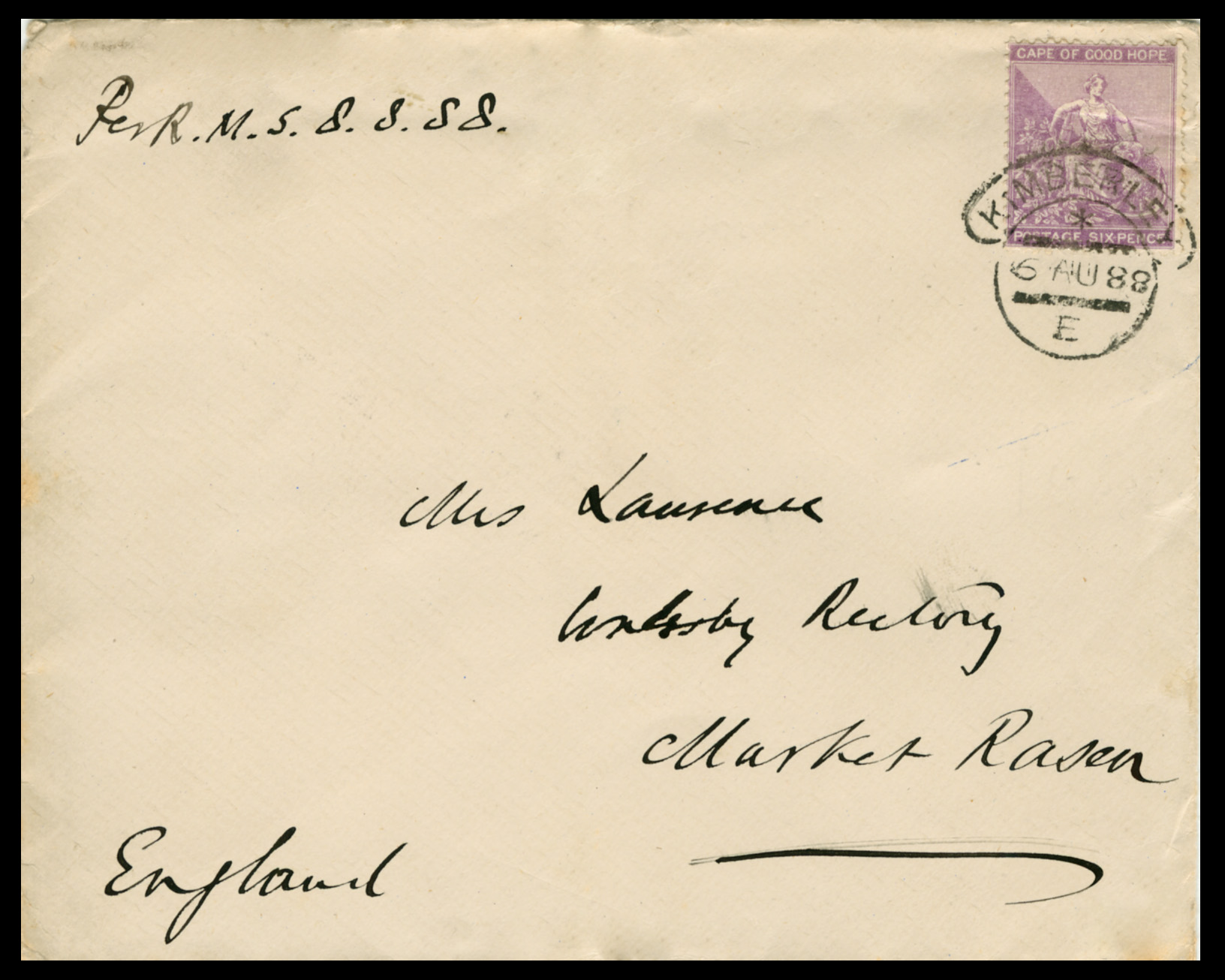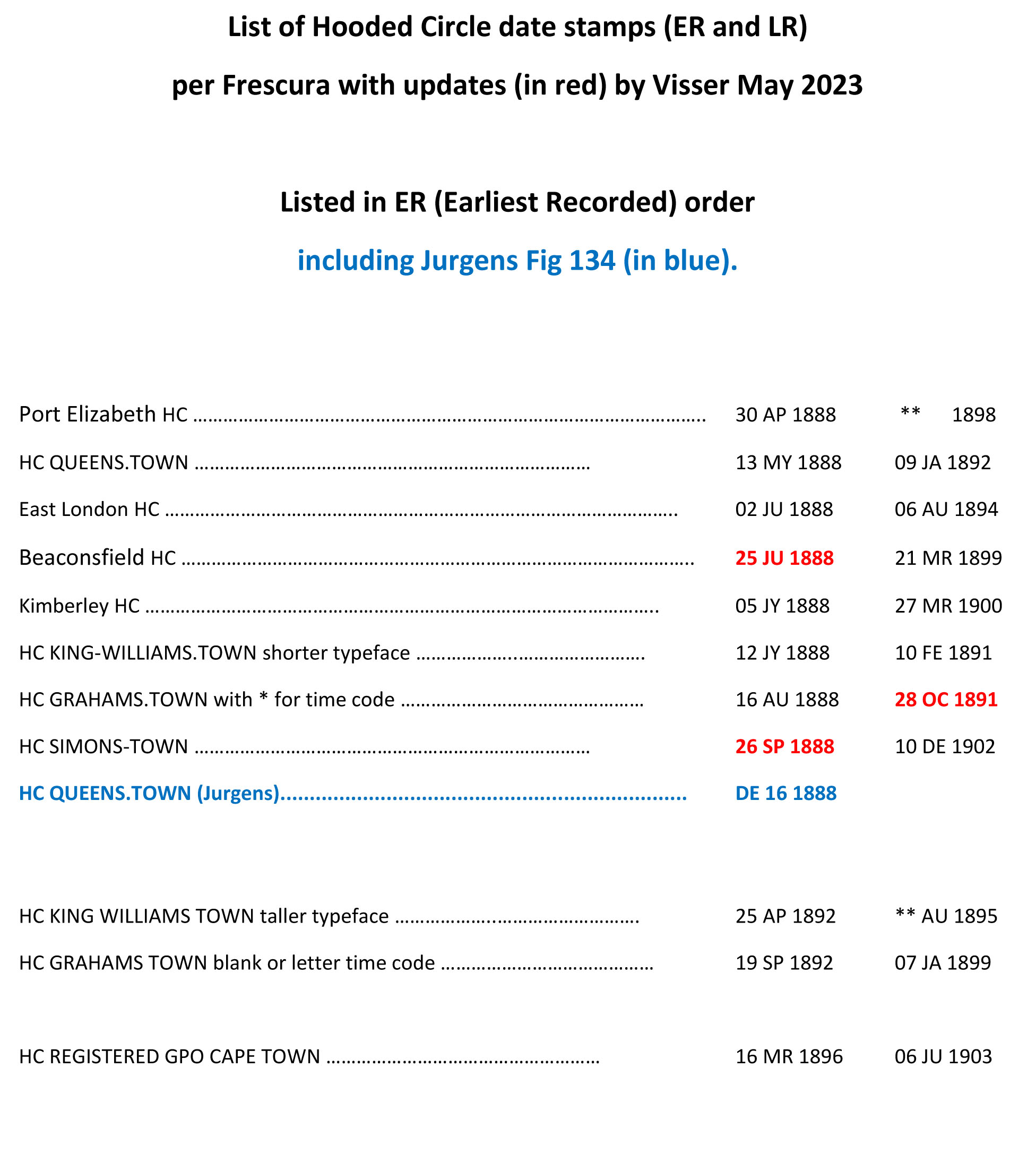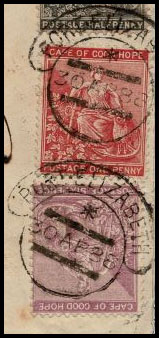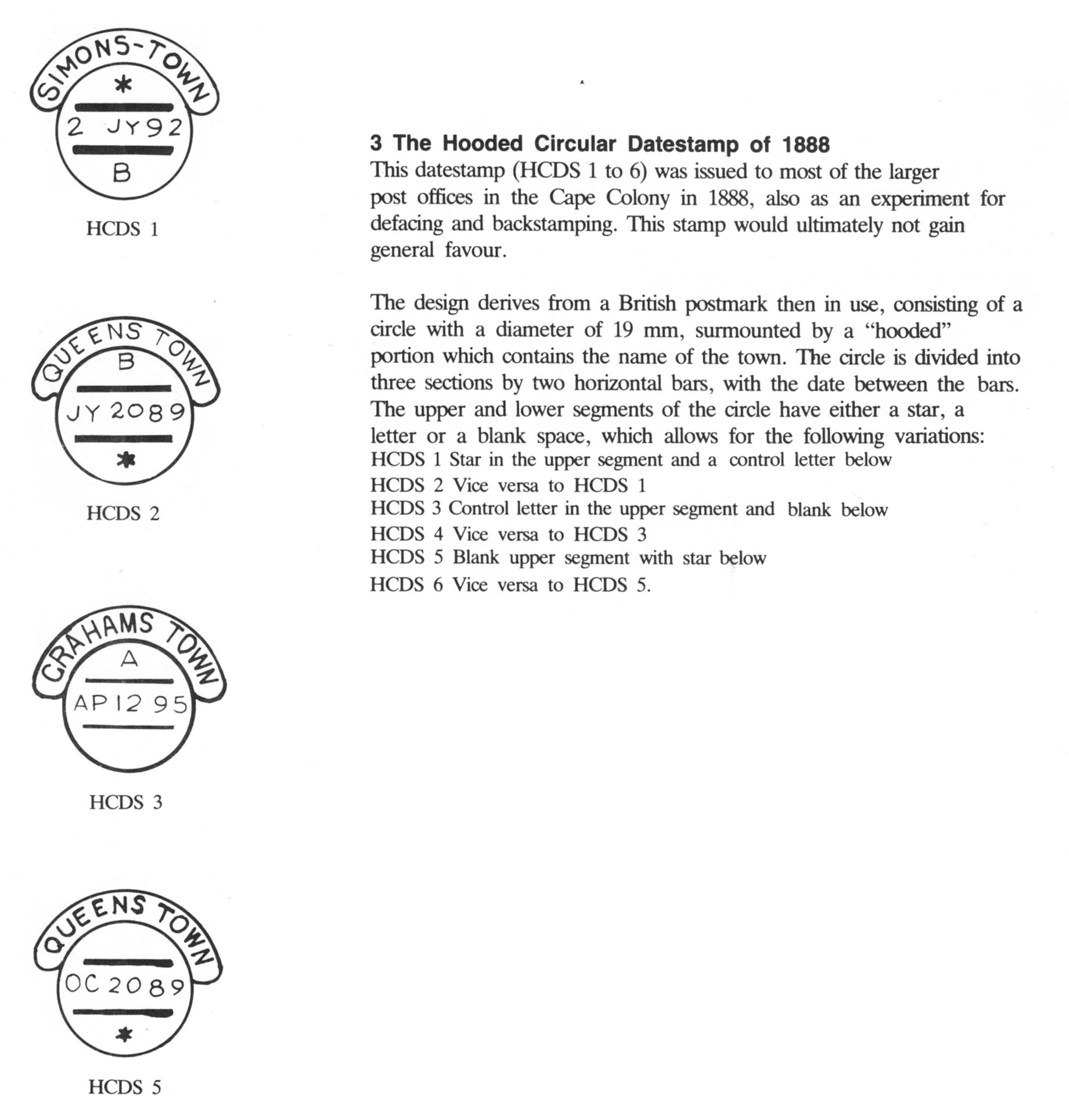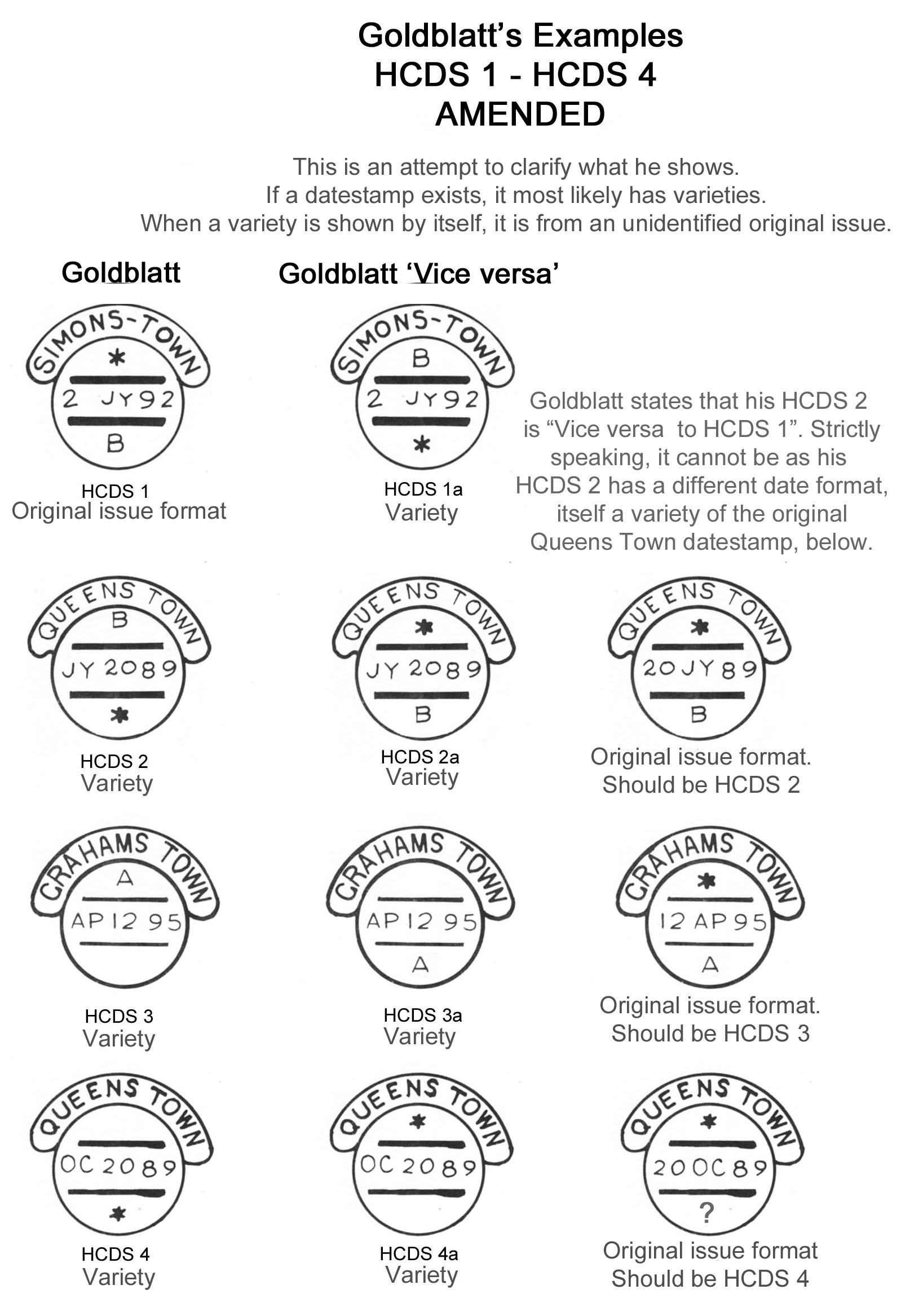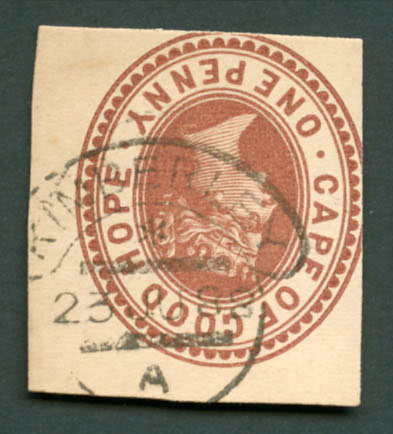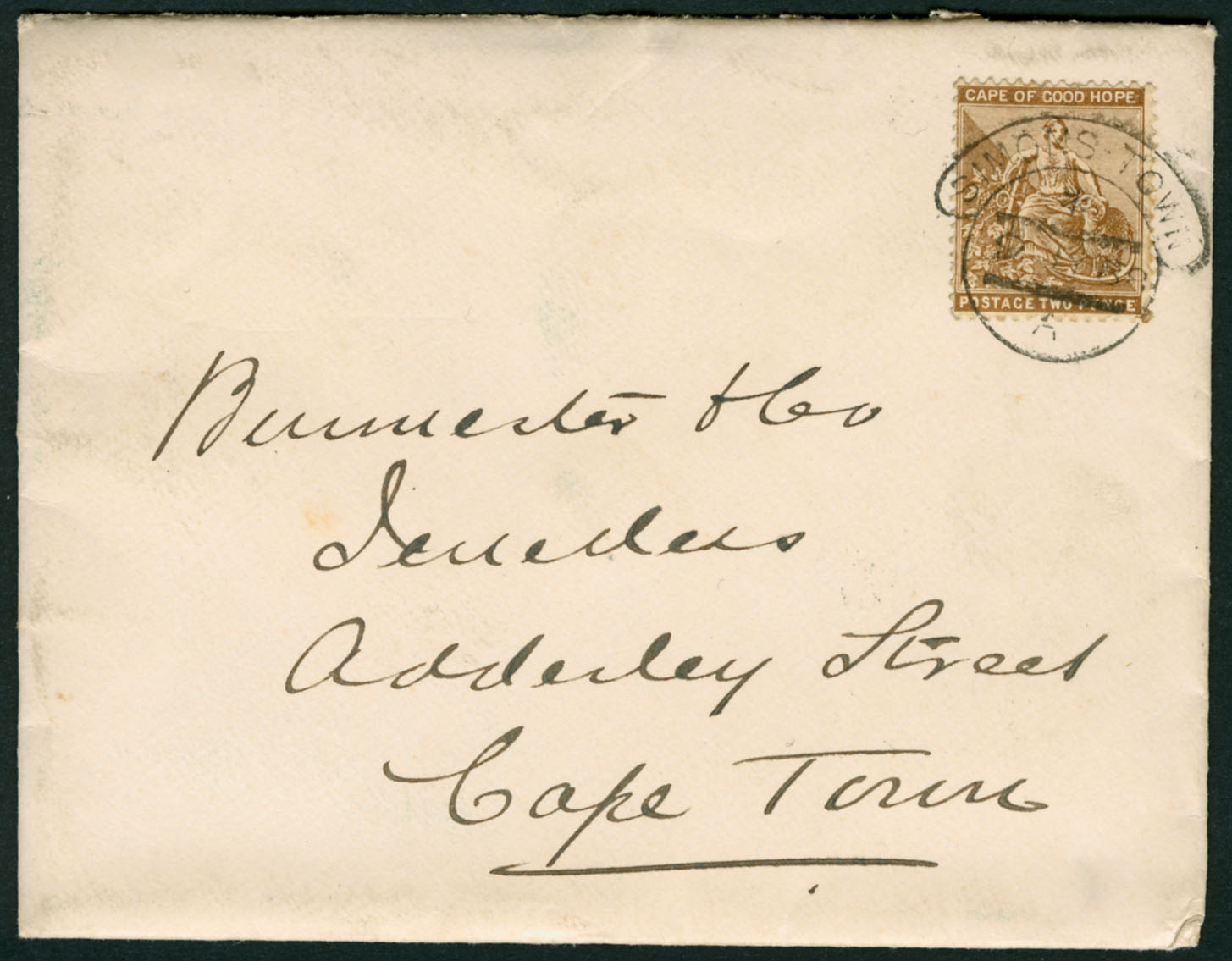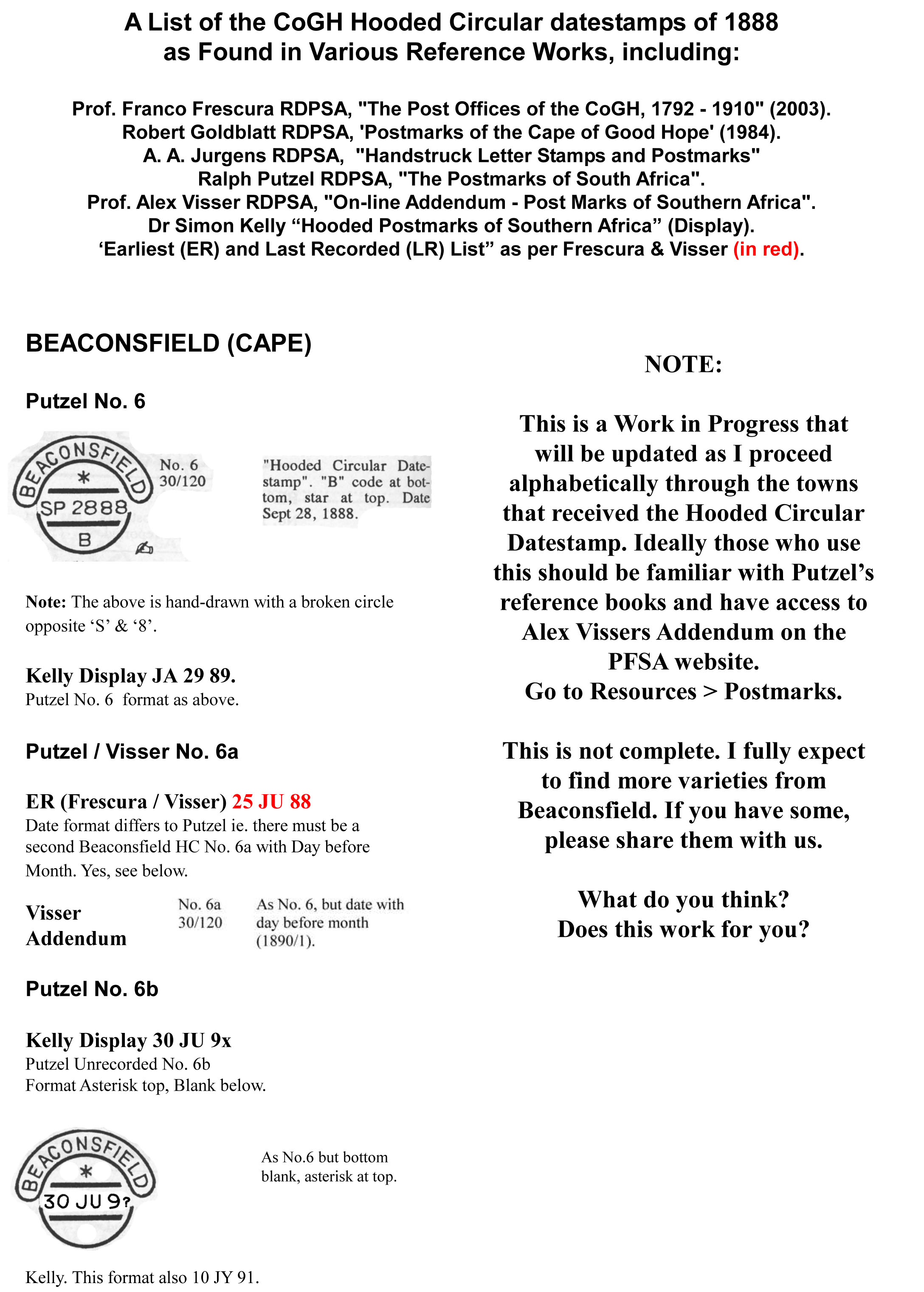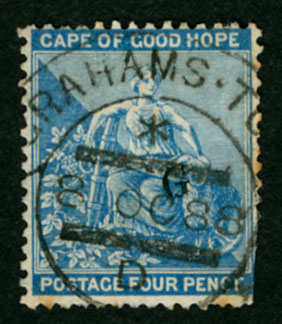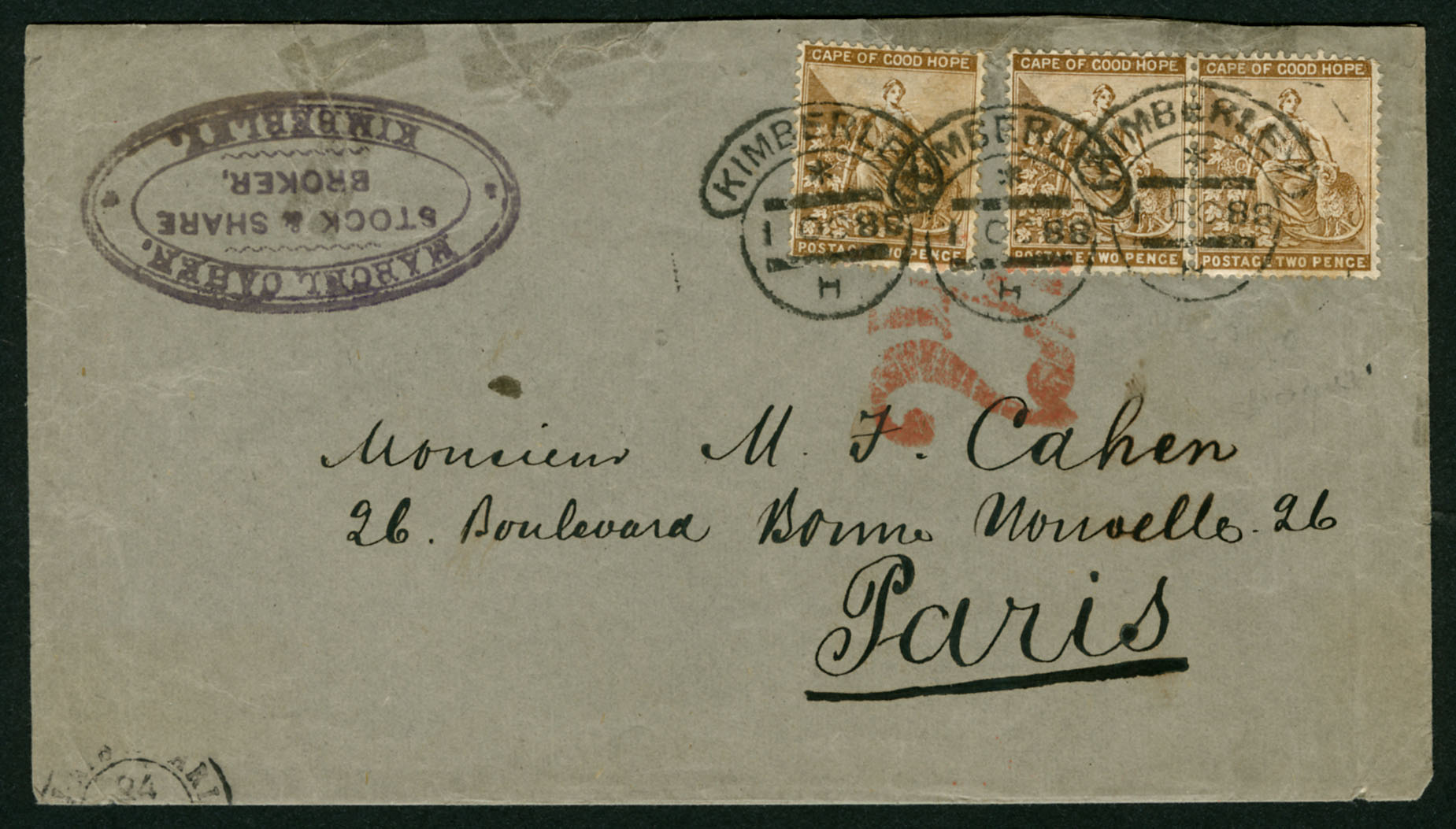The Hooded Datestamps of Southern Africa 1888 - 1903
Quote from yannisl on May 21, 2023, 12:34 pmNice to see more contributions. Here is a Port Elizabeth one with an HF code. The F is a bit faint, but certainly not a C. FC can be found on Kimberley Hooded cancellers.
Nice to see more contributions. Here is a Port Elizabeth one with an HF code. The F is a bit faint, but certainly not a C. FC can be found on Kimberley Hooded cancellers.
Uploaded files:Quote from yannisl on May 21, 2023, 12:40 pmHere is a Grahamstown one with what looks like no asterisk and no time code, however I think there is a faint asterisk. Also one from PE addressed to te Water a prominent politician (Broederbond member) and member of Parliament.
Yannis. I have inadvertently deleted your lovely PE cover. Please replace it and delete this message. Steve.
Here is a Grahamstown one with what looks like no asterisk and no time code, however I think there is a faint asterisk. Also one from PE addressed to te Water a prominent politician (Broederbond member) and member of Parliament.
Yannis. I have inadvertently deleted your lovely PE cover. Please replace it and delete this message. Steve.
Uploaded files:Quote from Steve on May 22, 2023, 7:56 amVery nice and very useful, especially the HF code. Thank you, Yannis. I particularly like the early '89 PE cover.
Yesterday I thought I would try to write a summary of all I have learned about Hooded Circular datestamps. I thought I should check parts of that with Prof. Alex Visser RDPSA before publishing it. (I will carry on working on it today.) As a result of contacting Alex, he sent me the latest update to the list of EARLIEST AND LAST RECORDED dates of use (May 2023) as a MS Word DOC file . I show it below as a JPG file for you to view in this thread. If anyone should want it as a DOC file, please email me (editor@southafricanphilatelyclub.com).
PS: I have just spoken to Underbidder who will be suplying a variety of Hooded Circular postmarks for our 'edification and delight'. This will include a double letter time code from the mid-1890s. I didn't know they were using them so late. Posting this material may take some time as one of us will have to travel outside of his comfort zone to see the other. Watch this space in the next week or so!
Very nice and very useful, especially the HF code. Thank you, Yannis. I particularly like the early '89 PE cover.
Yesterday I thought I would try to write a summary of all I have learned about Hooded Circular datestamps. I thought I should check parts of that with Prof. Alex Visser RDPSA before publishing it. (I will carry on working on it today.) As a result of contacting Alex, he sent me the latest update to the list of EARLIEST AND LAST RECORDED dates of use (May 2023) as a MS Word DOC file . I show it below as a JPG file for you to view in this thread. If anyone should want it as a DOC file, please email me (editor@southafricanphilatelyclub.com).
PS: I have just spoken to Underbidder who will be suplying a variety of Hooded Circular postmarks for our 'edification and delight'. This will include a double letter time code from the mid-1890s. I didn't know they were using them so late. Posting this material may take some time as one of us will have to travel outside of his comfort zone to see the other. Watch this space in the next week or so!
Uploaded files:Quote from yannisl on May 22, 2023, 1:24 pmThanks Steve, very useful. Minor pedantic correction for Port Elizabeth the 30 AP 1888** the stars should be omitted? Here a screen capture of some notes I have on my computer regarding time codes, for Kimberley though. I think at the time I probably copied them from Goldblatt, worth checking. As you will see a blank code is not an error of a missing time code but denotes a particular time. Placing the * on top or bottom of the postmark, might also have had some meaning at least for some Post Offices. If anyone can get hold of the Post Office Guide of 1896, it might clarify a lot of answers.
Thanks Steve, very useful. Minor pedantic correction for Port Elizabeth the 30 AP 1888** the stars should be omitted? Here a screen capture of some notes I have on my computer regarding time codes, for Kimberley though. I think at the time I probably copied them from Goldblatt, worth checking. As you will see a blank code is not an error of a missing time code but denotes a particular time. Placing the * on top or bottom of the postmark, might also have had some meaning at least for some Post Offices. If anyone can get hold of the Post Office Guide of 1896, it might clarify a lot of answers.
Uploaded files:
Quote from Steve on May 22, 2023, 2:10 pmDitto! 'VERY USEFUL!' Wow! It is now all starting to fall into place.
Clearly Port Elizabeth and Kimberley were following British practices but were any other Cape Post Offices? Interested readers with examples should send them in, please. What I gather from this is that the Hooded Circular datestamp was updated up to 12 times during the day, each update having a potential for error / variety.
BTW, Jurgens shows a Kimberley Squared Circle 'JU 5 97' with a 'CF' time code but makes no mention of it. See page 73. I have had a quick skwizz at his book which has very little on Time Code letters. He ignored them. Incredible!
Sorry about the PE ** but that is how I received it. The ** confused me. I hoped someone would explain it. Thanks! Stars now deleted but not for ** 1898 which I assume means a Year but no Day or Month. Strikes me as odd.
I was trying to summarise all the wonderful information that has flowed from Simon's display and the conversation here. Here is the start of my 'summary'. Actually it is more of a long ramble.
The Cape Colony
HOODED CIRCULAR DATESTAMP
of 1888.What did the original Hooded Circular datestamp look like on the day of issue?
In attempting to answer this, I will look at the various reference books, starting with......
The Handstruck Letter Stamps and Postmarks. (A. A. Jurgens. 1943)
It is some time since A. A. Jurgens RDPSA FRPSL has been held up as a guide to Cape postal history. Nevertheless, in approaching the difficult subject of the Hooded Circular datestamp and its varieties he provides a useful starting point.
In his "Handstruck Letter Stamps and Postmarks" Jurgens asserts that the Hooded Circular datestamp of 1888 was "issued as shown" (below). This is a hand-drawn Queens-Town example with a time code letter above, the date in Month before Day before Year format between the bars and an asterisk at the bottom. Of the many varieties found in the setting of the Hooded Circular datestamp, Jurgens says that they "do not constitute true varieties of the Date Stamp; they are rather of the nature of errors due to incorrect setting of the type by the Postmaster". Further to Yannis' advice, it appears that Jurgens was unfamiliar with GB general codes as used in some Cape post offices where, for example. a blank space represented 'early'.
Image 1. Page 74. "Handstruck Letter Stamps and Postmarks". See below.
Queenstown 'DE 16 88'. Time Code 'K' top. asterisk bottom.Is Jurgens' image an example of "incorrect setting of the type by the Postmaster"?
The date of his hand-drawn postmark is 'DE 16 88'. The same image is used by Frescura in his "The Post Offices of the CoGH, 1792 - 1910" (2003). Although the date is the year of issue, Jurgens' and Frescura's example is seven months older than the earliest recorded use in Queens-Town on '13 May 88'. This would have provided ample time for "incorrect setting of the type by the Postmaster". It is possible that Jurgens' certainty is misplaced. It is possible that the Hooded Circular datestamp was issued with the asterisk top and the time code letter below. Who knows? (What was the UK format?) The early Queens-Town '13 May 88' cover probably holds the key to what the original looked like.
Image 2. An alternative to Jurgens baseless diktat.
Queenstown '16 DE 88'. Asterisk top. Time Code letter bottom.* The exact appearance of the Hooded Circular datestamp when issued needs to be clarified. We need several FDCs!
In Jurgens' opinion all of the eight post offices that were issued with this datestamp in 1888 received it "as shown" below. If true, the listings in the reference books of all eight Cape towns that received this Hooded Circular datestamp - Beaconsfield, East London, Grahams Town, Kimberley, King Williams Town, Port Elizabeth, Queenstown and Simons-Town - should start with an example of the Hooded Circular datestamp in the format Jurgen's shows.
See my Simons-Town cover of '26 SP 88'. The strike is crisp and clean suggesting that the datestamp is relatively new! It's the real thing on cover - not a drawing. It is just under three months earlier than Jurgens' offering. Surely, being closer to the date of issue, this has every bit as much of a claim to be what the original Hooded Circular datestamp looked like. And... it's also an unrecorded earliest date for Simons-Town!
Image 3. Simons-Town '26 SP 88'. Asterisk top. Time Code letter 'B' bottom.
Here is another of my covers, this one from Kimberley '6 AU 88', again, early-ish and four months earlier that Jurgens' example. It too has the format shown above ie. not Jurgens'. I am not saying this is conclusive, far from it, but perhaps it is enough to cast doubt on Jurgens' claim. I repeat - we need to see more early covers. We need to see what the earliest recorded dates of use show.
BTW, at first glance, this Kinberley Hooded Circular dafestamp appears fractionally smaller than the rest. I will make some measurements today! Watch this space!!
Image 4. KIMBERLEY '6 AU 88'. Asterisk top. Time Code letter 'E' bottom.
Finally, I have rearranged Prof. Alex Visser's list in Earliest Recorded order and included Jurgens' image date within it. As you can see, it appears at the bottom of the top list, showing us that it is far from the oldest example and the least likely to represent a pristine example of the type ie. it has had ample time to have been subjected to "incorrect setting of the type by the Postmaster".
Image 5. Rearranged list in Earliest Recorded order including Jurgens' image date within it
Next I will look at how the Hooded Circular datestamp is listed in various reference works. Will we glean anything at all from this exercise other than what we already know - that the listing is an unreliable higgledy-piggled mess?
Ditto! 'VERY USEFUL!' Wow! It is now all starting to fall into place.
Clearly Port Elizabeth and Kimberley were following British practices but were any other Cape Post Offices? Interested readers with examples should send them in, please. What I gather from this is that the Hooded Circular datestamp was updated up to 12 times during the day, each update having a potential for error / variety.
BTW, Jurgens shows a Kimberley Squared Circle 'JU 5 97' with a 'CF' time code but makes no mention of it. See page 73. I have had a quick skwizz at his book which has very little on Time Code letters. He ignored them. Incredible!
Sorry about the PE ** but that is how I received it. The ** confused me. I hoped someone would explain it. Thanks! Stars now deleted but not for ** 1898 which I assume means a Year but no Day or Month. Strikes me as odd.
I was trying to summarise all the wonderful information that has flowed from Simon's display and the conversation here. Here is the start of my 'summary'. Actually it is more of a long ramble.
The Cape Colony
HOODED CIRCULAR DATESTAMP
of 1888.
What did the original Hooded Circular datestamp look like on the day of issue?
In attempting to answer this, I will look at the various reference books, starting with......
The Handstruck Letter Stamps and Postmarks. (A. A. Jurgens. 1943)
It is some time since A. A. Jurgens RDPSA FRPSL has been held up as a guide to Cape postal history. Nevertheless, in approaching the difficult subject of the Hooded Circular datestamp and its varieties he provides a useful starting point.
In his "Handstruck Letter Stamps and Postmarks" Jurgens asserts that the Hooded Circular datestamp of 1888 was "issued as shown" (below). This is a hand-drawn Queens-Town example with a time code letter above, the date in Month before Day before Year format between the bars and an asterisk at the bottom. Of the many varieties found in the setting of the Hooded Circular datestamp, Jurgens says that they "do not constitute true varieties of the Date Stamp; they are rather of the nature of errors due to incorrect setting of the type by the Postmaster". Further to Yannis' advice, it appears that Jurgens was unfamiliar with GB general codes as used in some Cape post offices where, for example. a blank space represented 'early'.
Image 1. Page 74. "Handstruck Letter Stamps and Postmarks". See below.
Queenstown 'DE 16 88'. Time Code 'K' top. asterisk bottom.
Is Jurgens' image an example of "incorrect setting of the type by the Postmaster"?
The date of his hand-drawn postmark is 'DE 16 88'. The same image is used by Frescura in his "The Post Offices of the CoGH, 1792 - 1910" (2003). Although the date is the year of issue, Jurgens' and Frescura's example is seven months older than the earliest recorded use in Queens-Town on '13 May 88'. This would have provided ample time for "incorrect setting of the type by the Postmaster". It is possible that Jurgens' certainty is misplaced. It is possible that the Hooded Circular datestamp was issued with the asterisk top and the time code letter below. Who knows? (What was the UK format?) The early Queens-Town '13 May 88' cover probably holds the key to what the original looked like.
Image 2. An alternative to Jurgens baseless diktat.
Queenstown '16 DE 88'. Asterisk top. Time Code letter bottom.
* The exact appearance of the Hooded Circular datestamp when issued needs to be clarified. We need several FDCs!
In Jurgens' opinion all of the eight post offices that were issued with this datestamp in 1888 received it "as shown" below. If true, the listings in the reference books of all eight Cape towns that received this Hooded Circular datestamp - Beaconsfield, East London, Grahams Town, Kimberley, King Williams Town, Port Elizabeth, Queenstown and Simons-Town - should start with an example of the Hooded Circular datestamp in the format Jurgen's shows.
See my Simons-Town cover of '26 SP 88'. The strike is crisp and clean suggesting that the datestamp is relatively new! It's the real thing on cover - not a drawing. It is just under three months earlier than Jurgens' offering. Surely, being closer to the date of issue, this has every bit as much of a claim to be what the original Hooded Circular datestamp looked like. And... it's also an unrecorded earliest date for Simons-Town!
Image 3. Simons-Town '26 SP 88'. Asterisk top. Time Code letter 'B' bottom.
Here is another of my covers, this one from Kimberley '6 AU 88', again, early-ish and four months earlier that Jurgens' example. It too has the format shown above ie. not Jurgens'. I am not saying this is conclusive, far from it, but perhaps it is enough to cast doubt on Jurgens' claim. I repeat - we need to see more early covers. We need to see what the earliest recorded dates of use show.
BTW, at first glance, this Kinberley Hooded Circular dafestamp appears fractionally smaller than the rest. I will make some measurements today! Watch this space!!
Image 4. KIMBERLEY '6 AU 88'. Asterisk top. Time Code letter 'E' bottom.
Finally, I have rearranged Prof. Alex Visser's list in Earliest Recorded order and included Jurgens' image date within it. As you can see, it appears at the bottom of the top list, showing us that it is far from the oldest example and the least likely to represent a pristine example of the type ie. it has had ample time to have been subjected to "incorrect setting of the type by the Postmaster".
Image 5. Rearranged list in Earliest Recorded order including Jurgens' image date within it
Next I will look at how the Hooded Circular datestamp is listed in various reference works. Will we glean anything at all from this exercise other than what we already know - that the listing is an unreliable higgledy-piggled mess?
Uploaded files:Quote from Steve on May 23, 2023, 12:16 pmRIP Simon Kelly
This is as good a place as any to announce Simon's passing last Friday 19th.
Simon's family notified Tony Johnson, editor of the Springbok, and myself this morning wanting us to "know that it was a mercifully peaceful end - quite a relief after the struggle of the last couple of weeks. His three sons and two grandchildren have been keeping the house lively and busy in this difficult time. We are very happy to hear that Simon's work is being further disseminated - it is very much what he would have wanted".
RIP Simon Kelly
This is as good a place as any to announce Simon's passing last Friday 19th.
Simon's family notified Tony Johnson, editor of the Springbok, and myself this morning wanting us to "know that it was a mercifully peaceful end - quite a relief after the struggle of the last couple of weeks. His three sons and two grandchildren have been keeping the house lively and busy in this difficult time. We are very happy to hear that Simon's work is being further disseminated - it is very much what he would have wanted".
Quote from Steve on May 23, 2023, 4:01 pmI'm sorry but I was thrown of course today following the news of Simon's death.
Today being one of those days, I want to return to my last post on the subject of Jurgens' contribution to our understanding of the Hooded Circular datestamp or rather our inherited misunderstanding of it. Goldblatt drew heavily on Jurgens work. Goldblatt in turn influenced many of us. His book "Postmarks of the CoGH" remains popular despite a wealth of new knowledge now not recorded in it. The only alternative is Franco Frescura's work which surprisingly includeds Jurgens' Queenstown datestamp. More on that later.
I reiterate our need to see the earliest recorded examples of the use of the Hooded Circular datestamp if we are to better understand what the original datestamp looked like on the day of issue in the eight post offices that received them. However, as a word of caution, the datestamps providing examples of the latest earliest dates ie. Grahamstown and Simons Town, may be unreliable guides because during the long time they were in use they might have been altered before being recorded.
I assume all the Hooded Circular datestamps were issued on the same date. The earliest recorded date for Queens Town is '13 MY 88', some seven months earlier than the example Jurgens shows. If all eight datestamps were issued at the same time, the date of their release would be around the 30th April 1888 or earlier. An issue date of about 1st April 1888 is not far-fetched.
The first recorded use of the Hooded Circular datestamp was on the 30th April 1888 in Port Elizabeth. We are exceptionally lucky to be able to see this cover supplied by Yannis. It provides an early insight into what this misunderstood datestamp might have looked like. Most interestingly, the Hooded Circular datestamp on this cover looks nothing like Jurgens' eight months later datestamp which he would have us believe was the original design.
Image 1. Port Elizabeth Hooded Circular datestamp '30 AP 88'.
This is the earliest recorded example of the Hooded Circular datestamp.
This is the best indicator we have as to what the original datestamp looked like!Of interest here is that Yannis' cover has a dot between 'Port' and 'Elizabeth'.
Other than town name, there are three significant differences between this, the earliest recorded Hooded Circular datestamp, and Jurgens' much later offering of almost 8 months later.
1]. There is an asterisk top. (Jurgens has a time code letter.)
2]. The date format is Day Month Year - '30 AP 88'. (Jurgens has Month Day Year - 'DE 16 88'.)
3]. The bottom is blank. (Jurgens has an asterisk.) A blank time code can indicate 'early'.A fourth and vitally important difference is that this is a datestamp on cover. It is not a made-up hand-drawn example.
I do not want to malign Jurgens unnecessarily but he was a flawed character who delighted in deceiving his peers. He provides no provenance for his hand-drawn example. As an early example of the type, it is a johnny-come-lately that he could have fabricated himself. I am grateful to Jurgens for getting the ball rolling but not for kicking it into the long grass which he then set alight in his own peculiar Veldfire of the Vanities. I submit that with regards to the Hooded Circular datestamp there is very little value in Jurgens' advice. We need to look elsewhere for answers.
I'm sorry but I was thrown of course today following the news of Simon's death.
Today being one of those days, I want to return to my last post on the subject of Jurgens' contribution to our understanding of the Hooded Circular datestamp or rather our inherited misunderstanding of it. Goldblatt drew heavily on Jurgens work. Goldblatt in turn influenced many of us. His book "Postmarks of the CoGH" remains popular despite a wealth of new knowledge now not recorded in it. The only alternative is Franco Frescura's work which surprisingly includeds Jurgens' Queenstown datestamp. More on that later.
I reiterate our need to see the earliest recorded examples of the use of the Hooded Circular datestamp if we are to better understand what the original datestamp looked like on the day of issue in the eight post offices that received them. However, as a word of caution, the datestamps providing examples of the latest earliest dates ie. Grahamstown and Simons Town, may be unreliable guides because during the long time they were in use they might have been altered before being recorded.
I assume all the Hooded Circular datestamps were issued on the same date. The earliest recorded date for Queens Town is '13 MY 88', some seven months earlier than the example Jurgens shows. If all eight datestamps were issued at the same time, the date of their release would be around the 30th April 1888 or earlier. An issue date of about 1st April 1888 is not far-fetched.
The first recorded use of the Hooded Circular datestamp was on the 30th April 1888 in Port Elizabeth. We are exceptionally lucky to be able to see this cover supplied by Yannis. It provides an early insight into what this misunderstood datestamp might have looked like. Most interestingly, the Hooded Circular datestamp on this cover looks nothing like Jurgens' eight months later datestamp which he would have us believe was the original design.
Image 1. Port Elizabeth Hooded Circular datestamp '30 AP 88'.
This is the earliest recorded example of the Hooded Circular datestamp.
This is the best indicator we have as to what the original datestamp looked like!
Of interest here is that Yannis' cover has a dot between 'Port' and 'Elizabeth'.
Other than town name, there are three significant differences between this, the earliest recorded Hooded Circular datestamp, and Jurgens' much later offering of almost 8 months later.
1]. There is an asterisk top. (Jurgens has a time code letter.)
2]. The date format is Day Month Year - '30 AP 88'. (Jurgens has Month Day Year - 'DE 16 88'.)
3]. The bottom is blank. (Jurgens has an asterisk.) A blank time code can indicate 'early'.
A fourth and vitally important difference is that this is a datestamp on cover. It is not a made-up hand-drawn example.
I do not want to malign Jurgens unnecessarily but he was a flawed character who delighted in deceiving his peers. He provides no provenance for his hand-drawn example. As an early example of the type, it is a johnny-come-lately that he could have fabricated himself. I am grateful to Jurgens for getting the ball rolling but not for kicking it into the long grass which he then set alight in his own peculiar Veldfire of the Vanities. I submit that with regards to the Hooded Circular datestamp there is very little value in Jurgens' advice. We need to look elsewhere for answers.
Uploaded files:Quote from Steve on May 24, 2023, 4:52 pmWe now come to Robert Goldblatt's contribution to the study of the Hooded Circular datestamp.
'Postmarks of the Cape of Good Hope'. (Robert Goldblatt, 1984.)
There is a accusation circulating that Goldblatt was overly reliant on Jurgens' work which he used as the basis for his popular book. The nub of the accusation is that some of Jurgens' misinformation was repeated by an unquestioning Goldblatt. Nevertheless, his book still remains the most widely used reference work for Cape postmarks today, most probably because it is an easy read and full of useful if dated information.
Goldblatt repeats the facts provided by Jurgens but has the good sense not to commit to declaring what the Hooded Circular datestamp looked like when issued. Like Jurgens, all of Goldblatt's postmarks have been hand-drawn. Like Jurgens, he disregards differences in the Date format. This is seen in his description of the first two postmarks that illustrate the section on 'The Hooded Circular Datestamps of 1888' (page 104) where he describes HCDS 2 as 'Vice versa to HCDS 1" ie. opposite of top and bottom. However, as these have different Date formats they are strictly speaking not one and the same. Putzel would list them as separate datestamps.
Goldblatt drops Jurgens' advice about what the Hooded Circular Datestamp looked like on its day of issue. Jurgens' controversial hand-drawn Queens Town datestamp, Fig. 134 only makes Goldblatt's HCDS 2. Goldblatt's has as his HCDS 1 a late Simons Town example from '2 JY 92'. Its format is identical to the earliest recorded Simons Town example of '26 SP 88', itself a relatively late example of the earliest types of this datestamp. Importantly, Goldblatt's HCDS 1 is closer than Jurgens' example to the format shown in the earliest recorded datestamp, the Port Elizabeth '30 SP 88' without time code letter at base. The absence of a time code letter in the Port Elizabeth example will not worry those who believe that a blank means "early".
Goldblatt's HCDS 2 is a later version of Jurgens' controversial "as issued" Queens Town datestamp, this one dated 'JY 20 89'. Of interest is the fact that Jurgen's 'Queens . Town' is separated by a dot, while neither of the two Goldblatt examples show a dot. One is correct and the other is wrong or there are two different datestamps.(Interesting!) The issue of the dot is unlikely to be what Jurgens calls "errors due to incorrect setting of the type by the Postmaster". Frescura lists the Queens Town dot (see Earliest Recorded list). The dot was probably made at the time of the datestamp's manufacture. Putzel provides no help. His sole Queens Town example, No. 8, is Jurgens' Fig. 134 with dot! Alex Visser's on-line Addendum does not list either of Goldblatt's two Queenstown hooded datestamps without a dot. Maybe this is something Jurgens got right!
It would appear that like Jurgens Goldblatt does not view the date difference as significant. In Putzel's reference books differences in date format are significant enough to warrant listing as separate varieties. Goldblatt illustrates four postmarks which he says create six variations. I disagree. On the basis of Goldblatt's HCDS 2 being a different and an new datestamp there should be be eight varieties. (Actually, there are more but we will come to that later.)
Goldblatt's HCDS 3 from Grahams Town is interesting if only because it has a time code letter above and is blank below ie. the asterisk is missing from this format. 5. Here the inclusion of a time code letter is curious as it means that this blank cannot stand for "early". Something else is going on. But what?
Goldblatt's HCDS 5 from Queens Town has a blank upper section with an asterisk below. The absence of a time code letter will not worry those who believe that in this instance a blank means "early".
All-in-all, Goldblatt's explanation of the Hooded Circular datestamp is only marginally more enlightening than Jurgens'. It is what he does not say that provides me with food for thought.
We now come to Robert Goldblatt's contribution to the study of the Hooded Circular datestamp.
'Postmarks of the Cape of Good Hope'. (Robert Goldblatt, 1984.)
There is a accusation circulating that Goldblatt was overly reliant on Jurgens' work which he used as the basis for his popular book. The nub of the accusation is that some of Jurgens' misinformation was repeated by an unquestioning Goldblatt. Nevertheless, his book still remains the most widely used reference work for Cape postmarks today, most probably because it is an easy read and full of useful if dated information.
Goldblatt repeats the facts provided by Jurgens but has the good sense not to commit to declaring what the Hooded Circular datestamp looked like when issued. Like Jurgens, all of Goldblatt's postmarks have been hand-drawn. Like Jurgens, he disregards differences in the Date format. This is seen in his description of the first two postmarks that illustrate the section on 'The Hooded Circular Datestamps of 1888' (page 104) where he describes HCDS 2 as 'Vice versa to HCDS 1" ie. opposite of top and bottom. However, as these have different Date formats they are strictly speaking not one and the same. Putzel would list them as separate datestamps.
Goldblatt drops Jurgens' advice about what the Hooded Circular Datestamp looked like on its day of issue. Jurgens' controversial hand-drawn Queens Town datestamp, Fig. 134 only makes Goldblatt's HCDS 2. Goldblatt's has as his HCDS 1 a late Simons Town example from '2 JY 92'. Its format is identical to the earliest recorded Simons Town example of '26 SP 88', itself a relatively late example of the earliest types of this datestamp. Importantly, Goldblatt's HCDS 1 is closer than Jurgens' example to the format shown in the earliest recorded datestamp, the Port Elizabeth '30 SP 88' without time code letter at base. The absence of a time code letter in the Port Elizabeth example will not worry those who believe that a blank means "early".
Goldblatt's HCDS 2 is a later version of Jurgens' controversial "as issued" Queens Town datestamp, this one dated 'JY 20 89'. Of interest is the fact that Jurgen's 'Queens . Town' is separated by a dot, while neither of the two Goldblatt examples show a dot. One is correct and the other is wrong or there are two different datestamps.(Interesting!) The issue of the dot is unlikely to be what Jurgens calls "errors due to incorrect setting of the type by the Postmaster". Frescura lists the Queens Town dot (see Earliest Recorded list). The dot was probably made at the time of the datestamp's manufacture. Putzel provides no help. His sole Queens Town example, No. 8, is Jurgens' Fig. 134 with dot! Alex Visser's on-line Addendum does not list either of Goldblatt's two Queenstown hooded datestamps without a dot. Maybe this is something Jurgens got right!
It would appear that like Jurgens Goldblatt does not view the date difference as significant. In Putzel's reference books differences in date format are significant enough to warrant listing as separate varieties. Goldblatt illustrates four postmarks which he says create six variations. I disagree. On the basis of Goldblatt's HCDS 2 being a different and an new datestamp there should be be eight varieties. (Actually, there are more but we will come to that later.)
Goldblatt's HCDS 3 from Grahams Town is interesting if only because it has a time code letter above and is blank below ie. the asterisk is missing from this format. 5. Here the inclusion of a time code letter is curious as it means that this blank cannot stand for "early". Something else is going on. But what?
Goldblatt's HCDS 5 from Queens Town has a blank upper section with an asterisk below. The absence of a time code letter will not worry those who believe that in this instance a blank means "early".
All-in-all, Goldblatt's explanation of the Hooded Circular datestamp is only marginally more enlightening than Jurgens'. It is what he does not say that provides me with food for thought.
Uploaded files:Quote from yannisl on May 25, 2023, 12:17 pmFirst, let me express how sorry I was to hear of Simon's passing; may he rest in peace.
Steve, I appreciate how you trying to summarize the information, and I must congratulate you on your Simon's Town find. It is really an excellent find. Are you going to add the information from Putzel as well? On types regarding the absence or not of the *, it must be noted that this was inserted as a slug, so the postmaster could add it or not. Same for the time code.
First, let me express how sorry I was to hear of Simon's passing; may he rest in peace.
Steve, I appreciate how you trying to summarize the information, and I must congratulate you on your Simon's Town find. It is really an excellent find. Are you going to add the information from Putzel as well? On types regarding the absence or not of the *, it must be noted that this was inserted as a slug, so the postmaster could add it or not. Same for the time code.
Quote from Steve on May 25, 2023, 5:46 pmSimon generously gave me his display for others he did not know to view on this website. This has increased the number of people who share the family's loss. You are right - may he rest in piece - but knowing a little of Simon he is probably already looking for another challenge!
Thanks for the kind words. I have just found two more ERs - Earliest Recorded dates. See below. I have sent them off to Alex Visser a half-an-hour or so ago. The new Simonstown was buried in a Kimberley collection where I found the Kimberley ER also. Interestingly, both are in the same format - Asterisk on top, Time code below and date in centre in Day before Month before Year format. I am seeing this more and more with early Hooded Circular Datestamps. I think Jurgens was right in as much as the varities were introduced by postal staff for a variety of reasons after the datestamp was introduced - but not in the date format he claims. Contrary to Jurgens' assertion in his book about what the HCD looked like on issue, I am increasingly of the opinion that it was Asterisk on top, Time code below and date in centre in Day before Month before Year format. However, I am not yet ready to bet your life on it! We need more early examples before I do.
- See the Grahamstown stamp below with annoying 'G'.
- *See the early Kimberley cover with the same date format. Bottom.
I started on Putzel today but was made to go shopping which upset my productivity and train of thought. As a consequence I did not get much done. I attach an unfinished sheet showing identified and unidentified Beaconsfield HCDs. Please let me know if the format is confusing. I have tried to make it look like Ralph Putzel's reference work / Alex Visser's Addendum with notes. Once I have some feedback I will reset it in a more conventional style
Regarding the asterisk slug, I take your point. However, it was a supplied feature of the HCDs to be used or not and when it wasn't or was moved around it created varieties of sorts which in my opinion are ones worthy of listing.
Simon generously gave me his display for others he did not know to view on this website. This has increased the number of people who share the family's loss. You are right - may he rest in piece - but knowing a little of Simon he is probably already looking for another challenge!
Thanks for the kind words. I have just found two more ERs - Earliest Recorded dates. See below. I have sent them off to Alex Visser a half-an-hour or so ago. The new Simonstown was buried in a Kimberley collection where I found the Kimberley ER also. Interestingly, both are in the same format - Asterisk on top, Time code below and date in centre in Day before Month before Year format. I am seeing this more and more with early Hooded Circular Datestamps. I think Jurgens was right in as much as the varities were introduced by postal staff for a variety of reasons after the datestamp was introduced - but not in the date format he claims. Contrary to Jurgens' assertion in his book about what the HCD looked like on issue, I am increasingly of the opinion that it was Asterisk on top, Time code below and date in centre in Day before Month before Year format. However, I am not yet ready to bet your life on it! We need more early examples before I do.
- See the Grahamstown stamp below with annoying 'G'.
- *See the early Kimberley cover with the same date format. Bottom.
I started on Putzel today but was made to go shopping which upset my productivity and train of thought. As a consequence I did not get much done. I attach an unfinished sheet showing identified and unidentified Beaconsfield HCDs. Please let me know if the format is confusing. I have tried to make it look like Ralph Putzel's reference work / Alex Visser's Addendum with notes. Once I have some feedback I will reset it in a more conventional style
Regarding the asterisk slug, I take your point. However, it was a supplied feature of the HCDs to be used or not and when it wasn't or was moved around it created varieties of sorts which in my opinion are ones worthy of listing.
Uploaded files:


